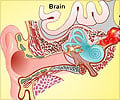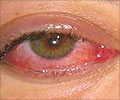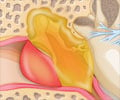- A Textbook Of Oral Pathology, Shafer, Hine and Levy 4th edition 1999 Wikipedia
- Bell Charles. On the nerves of the face: being a second paper on that subject. Philos Trans R Soc London. 1829; 119:317-30 [As cited in Kelly EC (ed). Classics of Neurology. New York: Robert E. Krieger Publishing; 1971, pp. 75-89].
- Bell, Charles. On the nerves of the face: being a second paper on that subject. Philos Trans R Soc London. 1829; 119:317-30 [As cited in Kelly EC (ed). Classics of Neurology. New York : Robert E. Krieger Publishing; 1971, pp. 75-89].
About
Bell's palsy results in weakness of the facial muscles. Its cause is unknown but most people make a full recovery from it within 8 to 12 weeks.

Bell's Palsy is usually a type of temporary sudden paralysis that causes weakness of the muscles of the face on one side. Rarely it can affect both sides. The facial nerve that supplies the muscles of the face is affected by the palsy. This nerve is called the facial nerve (the seventh of the twelve nerves that supply the face and neck regions).
It is one of the most common problems that affects the cranial nerves and is also the most common cause of facial paralysis all over the world.
Leonardo da Vinci's Mona Lisa has fascinated many with her enigmatic smile. Her smile has been the subject of intense debate for centuries. One theory put forward in 1989 suggested that the famous expression was the result of changes in facial muscles - partial degeneration followed by regeneration - that occur after Bell's palsy.
Bell's Palsy - Anatomy
Sir Charles Bell first described the condition in 1829 as follows:
The forehead of the [affected] side is without motion, the eyelids remain open, the nostril has no motion in breathing, and the mouth is drawn to the opposite side. In this man the sensibility is perfect. - (Charles Bell, 1829).
The facial nerve as the name indicates supplies most of the face. The nerve is responsible for the expressions of the face like - smiling and frowning. It also supplies the muscles that are used to close the eyelids. This seventh cranial nerve is also responsible for taking the taste sensations from the front of the tongue to the brain.
The nerve enters the face in front of the ear and if you place your index finger right in front of the ear, you will be able to feel the pulsations where the nerve enters the face.
The nerve has a very complex course from the brain and as it passes through the skull bone at its base where it is closely related to the ear. It passes through a bony canal before it emerges to supply the facial muscles.
It is felt that the complex course of the nerve is the main reason for it to be prone to injury or any viral infection that results in its swelling and compression of the nerve in the bony canal. As the infection and swelling resolve the palsy disappears.
Causes of Bell's Palsy
The cause of facial paralysis remains unknown. Exposure to cold is the most common precipiatating factor of the Bell's palsy, The inflammation and swelling of the nerve; it has been suggested is due to a viral infection and there is some evidence to suggest that it maybe the cold sore virus (herpes simplex virus) that causes it.
The facial palsy can also be caused by
- Head injury
- Sarcoidosis
- Lyme disease
- Stroke

In these conditions there is a known cause for the palsy and hence are not called Bells palsy. Some researchers have speculated that it is linked to genetics.
Incidence and Prevalence of Bell's Palsy
- Bell's palsy is more likely to occur between 15-45 years.
- It is very rare before 15 years of age and after 60 years of age.
- It affects men and women equally.
- It is three times more likely to affect pregnant women.
- Pregnant women who get affected by this condition have a bad prognosis.
- The disease affects 1 in 65 people at some point of time during their life.
- It is four times more likely to occur in diabetic individuals.
- Although there is no racial predilection, Bell's palsy appears to occur with a slightly more frequency in people of Japanese descent.
Symptoms of Bell's Palsy
Weakness of Facial Muscles: The Facial muscles weakness on one side of the face develops suddenly over a few hours. The patient usually wakes up in the morning and finds the weakness. The weakness gets worse over few days and the effects of the weakness vary, depending on whether the nerve is partially or fully affected.
The following symptoms maybe experienced by the patient
- The forehead on the affected side shows an absence of wrinkles.
- The eye does not blink thus exposing it to the risk of infections due to dryness.
- The mouth droops and sometimes saliva my run from it.
- On chewing food the food may get trapped between the gum and cheek on the affected side.
- The Palsy becomes noticeable when the patient tries to smile but the mouth on the affected side does not lift up and remains drooped.
- One is not able to blow or whistle.
Pain Behind the Ear: Most cases are painless, but an ache near the ear may occur for a few days before the palsy sets in and may continue to be there for another few days.
Sound: The tiny muscle in the ear may stop working and this may result in the normal sounds being heard louder than usual and sometimes these normal sound maybe unbearable for the patient
Taste Sensation: It is also noted that some patients complain of altered taste sensation on the side of the tongue.
Dry or Watery Eyes: Eyes are either dry or watery since one of the last branches of the facial nerve supplies the eye. If the muscles of the upper eyelid is affected it leads to the inability to close the eyelids and due to constant exposure result in dry eye and infection. Watery eyes are due to the fact that the muscle, which holds the tear sac together becomes loose. This causes the flow of tears to become copious. Many patients seek a doctor's opinion out of fear that they have either suffered from a stroke or have cancer.












